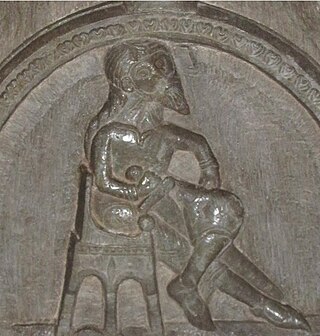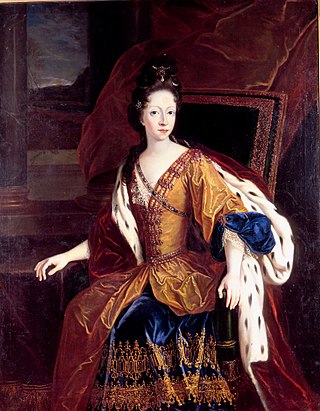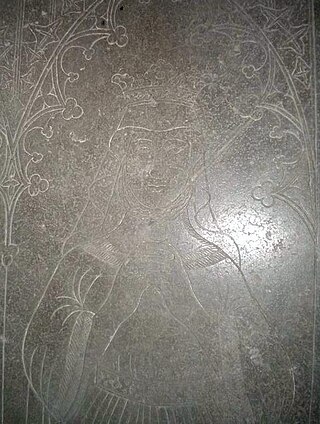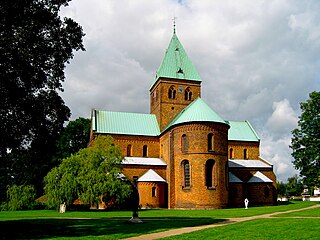
Valdemar I Knudsen, also known as Valdemar the Great, was King of Denmark from 1154 until his death in 1182. The reign of King Valdemar I saw the rise of Denmark, which reached its medieval zenith under his son King Valdemar II.
Richeza of Poland, a member of the House of Piast, was twice Queen of Sweden and once Princess of Minsk through her three marriages. Tradition describes her as unusually beautiful.

Sverker the Elder, also known as Sverker I, was King of Sweden from about 1132 until his murder. Of non-royal descent, he founded the House of Sverker, the rulers of which alternated with the rival House of Erik over the next century.

Margaret Sambiria was Queen of Denmark by marriage to King Christopher I, and regent during the minority of her son, King Eric V from 1259 until 1264. She is the first woman confirmed to have formally ruled as regent of Denmark. She was the reigning fief-holder of Danish Estonia in 1266–1282.

Canute V Magnussen was a King of Denmark from 1146 to 1157, as co-regent in shifting alliances with Sweyn III and Valdemar I. Canute was killed at the so-called Bloodfeast of Roskilde in 1157. Nothing certain is known about his person and character.

Ingeborg of Norway was a Norwegian princess and by marriage a Swedish royal duchess with a position in the regency governments in Norway (1319–1327) and Sweden (1319–1326) during the minority of her son, King Magnus Eriksson. In 1318–1319, she was Sweden's de facto ruler, and from 1319 until 1326, she was Sweden's first de jure female regent. Her role in northern European history is considered of major importance.

Princess Sophia Hedwig of Denmark and Norway was a Danish princess, the daughter of King Christian V and his queen-consort, Charlotte Amalie of Hesse-Kassel.

Sophia of Denmark was Queen of Sweden as the consort of King Valdemar.

Rikissa of Denmark was Queen of Sweden as the wife of King Erik Knutsson, and the mother of King Erik Eriksson.
Helen, is the assumed name of a medieval Swedish princess and Danish queen, Queen consort of King Canute V of Denmark. The date of her birth is not known; her father was King Sverker I of Sweden and her mother has been assumed to be Sverker's first spouse, Queen Ulvhild.

Ingeborg Magnusdotter was Queen of Denmark by marriage to King Eric VI. She was the daughter of King Magnus Ladulås of Sweden and Helvig of Holstein.

Jutta of Saxony was Queen of Denmark as the wife of King Eric IV of Denmark. She was the daughter of Albert I, Duke of Saxony. She married king Erik in 1239, and became junior queen consort, since her husband was junior king, even though there was no senior queen at the time. She would become senior queen in 1242.

Christina Ingesdotter was a Swedish princess and a princess consort of Veliky Novgorod, Rostov and Belgorod, by marriage to Grand Prince Mstislav I of Kiev.

St. Bendt's Church is a church in Ringsted, Denmark, which was originally part of a Benedictine monastery that burnt down in the 18th century. Built in the Romanesque style, it is the oldest brick church in Scandinavia, dating back to about 1170 when it replaced a travertine church from about 1080. It is considered to be one of Denmark's architecturally finest churches. Furthermore, it is of special historical interest as it is the first Royal church in Denmark and it houses the tombs of many of Denmark's earlier monarchs and noblemen.
Ingeborg Mstislavna of Kiev was a Ruthenian princess, married to the Danish prince Canute Lavard of Jutland.

Jutta of Denmark also known as Judith (1246-1286/95) was a daughter of Eric IV of Denmark and his wife Jutta of Saxony. She was a younger sister of Queen Sophia of Sweden, and Queen Ingeborg of Norway, as well as an older sister of Agnes. Jutta was also mistress for a brief period of time to her brother-in-law Valdemar, King of Sweden. Jutta was a member of the House of Estridsen.

The House of Estridsen was a dynasty that provided the kings of Denmark from 1047 to 1412. The dynasty is named after its ancestor Estrid Svendsdatter. The dynasty is sometimes called the Ulfinger, after Estrid's husband, Ulf Jarl. The dynasty also provided three medieval rulers of Sweden and one of Norway. Their family coat of arms became the coat of arms of Denmark and thereby influenced the coat of arms of Tallinn and the coat of arms of Estonia.
Erik Eriksøn, also known as Eric Longlegs, (1272–1310), Lord of Langeland, was the second son of Eric I, Duke of Schleswig and younger brother of Valdemar IV, Duke of Schleswig.
Henrik Svendsen, better known as Henrik Skadelår or Henrik the Lame, was a Danish prince and pretender through his father, Svend Tronkræver, an illegitimate son of King Sweyn II. He died in the Battle of Fotevik before he could press his claim.
Events from the 12th century in Denmark.
















